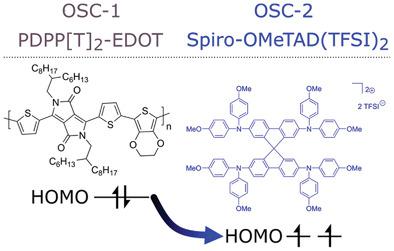当前位置:
X-MOL 学术
›
Adv. Mater.
›
论文详情
Our official English website, www.x-mol.net, welcomes your
feedback! (Note: you will need to create a separate account there.)
HOMO-HOMO Electron Transfer: An Elegant Strategy for p-Type Doping of Polymer Semiconductors toward Thermoelectric Applications.
Advanced Materials ( IF 27.4 ) Pub Date : 2020-09-18 , DOI: 10.1002/adma.202003596 Mahima Goel 1 , Marie Siegert 2 , Gert Krauss 1 , John Mohanraj 1 , Adrian Hochgesang 1 , David C Heinrich 1 , Martina Fried 1 , Jens Pflaum 2 , Mukundan Thelakkat 1, 3
Advanced Materials ( IF 27.4 ) Pub Date : 2020-09-18 , DOI: 10.1002/adma.202003596 Mahima Goel 1 , Marie Siegert 2 , Gert Krauss 1 , John Mohanraj 1 , Adrian Hochgesang 1 , David C Heinrich 1 , Martina Fried 1 , Jens Pflaum 2 , Mukundan Thelakkat 1, 3
Affiliation

|
Unlike the conventional p‐doping of organic semiconductors (OSCs) using acceptors, here, an efficient doping concept for diketopyrrolopyrrole‐based polymer PDPP[T]2‐EDOT (OSC‐1) is presented using an oxidized p‐type semiconductor, Spiro‐OMeTAD(TFSI)2 (OSC‐2), exploiting electron transfer from HOMOOSC‐1 to HOMOOSC‐2. A shift of work function toward the HOMOOSC‐1 upon doping is confirmed by ultraviolet photoelectron spectroscopy (UPS). Detailed X‐ray photoelectron spectroscopy (XPS) and UV–vis–NIR absorption studies confirm HOMOOSC‐1 to HOMOOSC‐2 electron transfer. The reduction products of Spiro‐OMeTAD(TFSI)2 to Spiro‐OMeTAD(TFSI) and Spiro‐OMeTAD is also confirmed and their relative amounts in doped samples is determined. Mott–Schottky analysis shows two orders of magnitude increase in free charge carrier density and one order of magnitude increase in the charge carrier mobility. The conductivity increases considerably by four orders of magnitude to a maximum of 10 S m−1 for a very low doping ratio of 8 mol%. The doped polymer films exhibit high thermal and ambient stability resulting in a maximum power factor of 0.07 µW m−1 K−2 at a Seebeck coefficient of 140 µV K−1 for a very low doping ratio of 4 mol%. Also, the concept of HOMOOSC‐1 to HOMOOSC‐2 electron transfer is a highly efficient, stable and generic way to p‐dope other conjugated polymers.
中文翻译:

HOMO-HOMO电子转移:面向热电应用的聚合物半导体p型掺杂的绝佳策略。
与传统的使用受体对有机半导体(OSC)进行传统的p掺杂不同,此处提出了一种使用氧化的p型半导体Spiro-的基于二酮吡咯并吡咯的聚合物PDPP [T] 2 -EDOT(OSC-1)的有效掺杂概念。OMeTAD(TFSI)2(OSC-2),利用了从HOMO OSC-1到HOMO OSC-2的电子转移。紫外光电子能谱(UPS)证实了掺杂后功函向HOMO OSC-1转移。详细的X射线光电子能谱(XPS)和UV-vis-NIR吸收研究证实了HOMO OSC-1至HOMO OSC-2电子的转移。Spiro-OMeTAD(TFSI)2的还原产物同时确定了Spiro-OMeTAD(TFSI)和Spiro-OMeTAD的含量,并确定了它们在掺杂样品中的相对含量。莫特-肖特基分析显示自由电荷载流子密度增加两个数量级,而电荷载流子迁移率增加一个数量级。对于8mol%的非常低的掺杂率,电导率显着增加四个数量级,至最大10 S m -1。掺杂的聚合物膜表现出高的热稳定性和环境稳定性,对于4 mol%的极低掺杂率,塞贝克系数为140 µV K -1时,最大功率因数为0.07 µW m -1 K -2。同样,从HOMO到HOMO OSC-1的概念OSC-2电子转移是p掺杂其他共轭聚合物的高效,稳定且通用的方法。
更新日期:2020-10-26
中文翻译:

HOMO-HOMO电子转移:面向热电应用的聚合物半导体p型掺杂的绝佳策略。
与传统的使用受体对有机半导体(OSC)进行传统的p掺杂不同,此处提出了一种使用氧化的p型半导体Spiro-的基于二酮吡咯并吡咯的聚合物PDPP [T] 2 -EDOT(OSC-1)的有效掺杂概念。OMeTAD(TFSI)2(OSC-2),利用了从HOMO OSC-1到HOMO OSC-2的电子转移。紫外光电子能谱(UPS)证实了掺杂后功函向HOMO OSC-1转移。详细的X射线光电子能谱(XPS)和UV-vis-NIR吸收研究证实了HOMO OSC-1至HOMO OSC-2电子的转移。Spiro-OMeTAD(TFSI)2的还原产物同时确定了Spiro-OMeTAD(TFSI)和Spiro-OMeTAD的含量,并确定了它们在掺杂样品中的相对含量。莫特-肖特基分析显示自由电荷载流子密度增加两个数量级,而电荷载流子迁移率增加一个数量级。对于8mol%的非常低的掺杂率,电导率显着增加四个数量级,至最大10 S m -1。掺杂的聚合物膜表现出高的热稳定性和环境稳定性,对于4 mol%的极低掺杂率,塞贝克系数为140 µV K -1时,最大功率因数为0.07 µW m -1 K -2。同样,从HOMO到HOMO OSC-1的概念OSC-2电子转移是p掺杂其他共轭聚合物的高效,稳定且通用的方法。










































 京公网安备 11010802027423号
京公网安备 11010802027423号